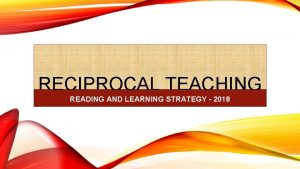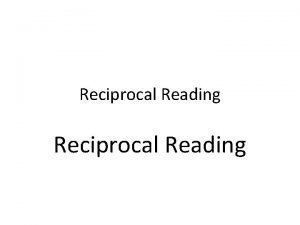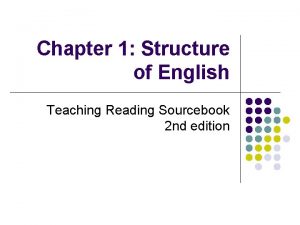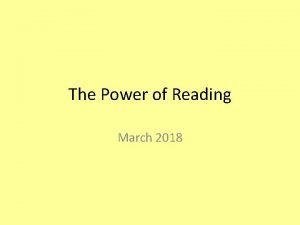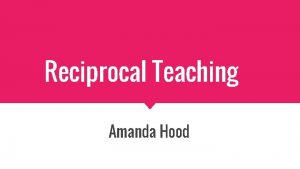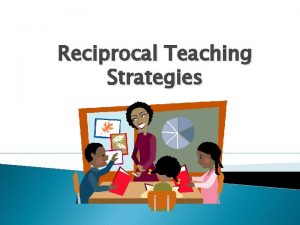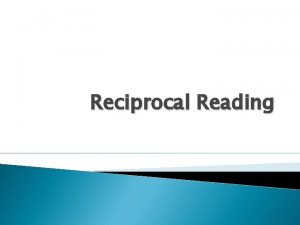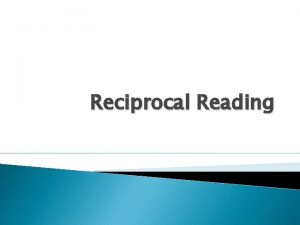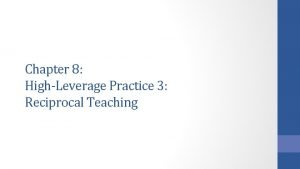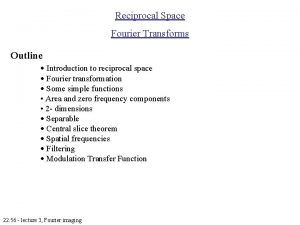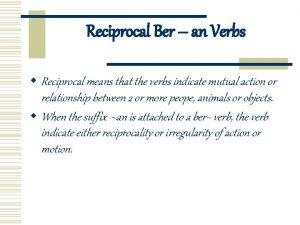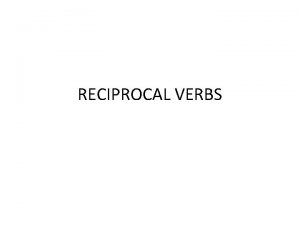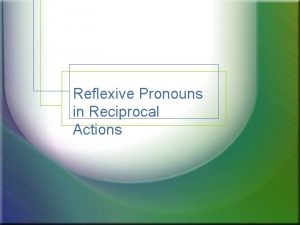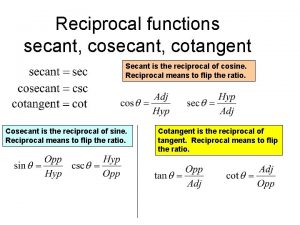Reciprocal Reading What is Reciprocal Reading Reciprocal teaching













- Slides: 13

Reciprocal Reading

What is Reciprocal Reading? Reciprocal teaching refers to an activity in which students become the teacher in small group reading sessions. Teachers model, then help students learn to guide group discussions using four strategies: • summarising • questioning • Clarifying • predicting Once students have learned the strategies, they take turns assuming the role of teacher in leading a dialogue about what has been read.

Why use Reciprocal Reading? • It encourages students to think about their own thought process during reading. • It helps students to learn to be actively involved and monitor their comprehension as they read. • It teaches students to ask questions during reading and helps to make the text more comprehensible.

Before we start…. • Before Reciprocal Teaching can be used successfully by your students, they need to have been taught and had time to practice the four strategies that are used in reciprocal teaching: • Summarising • Questioning • Predicting • clarifying

Before we start (Cont. ) • During the introductory sessions, the pupils should be given the Task Cue Cards. • Take the pupils through the text, paragraph at a time, modelling the tasks on the Task Cue Cards.

How to run Reciprocal Reading

Step One • Put pupils into mixed ability groups of four or five. • If in groups of four, it is good to give someone the job of Big Boss as well as another task OR if it is a group that needs a lot of support, the teacher or assistant could be the Big Boss.

Step Two • Assign each child a Task Cue Card. • You can either let pupils keep this card for the entire lesson or rotate through the tasks after each section of text is read. • If they keep with the one card for the whole session, make sure that they use a different card for the next lesson.

Step Three • The Big Boss, tells the group how much they are going to read during the first section. This would normally be one or two paragraphs of the text depending on the length. • This could be read together or individually. • Depending on the competency of the pupils, it could be read together (choral style) then silently for note taking.

Step Four • Each pupil takes notes according to their task: • Summariser takes notes on key elements • Questioner takes note to help form probing questions • Clarifier takes notes about things that may be confusing i. e. unusual words etc. and may consult a dictionary • Predictor takes notes about what he thinks may happen next.

Steps Five to Seven • The Big Boss invites each pupil to tell the group what he/she has been writing and thinking. Why do you I think that……. . It could be that he will either……… Maybe we are in for a shock! think…. . ? Where is he going to? I looked up the word ____ in the dictionary. It means ______ So far we have read that _______ happened because _____.

Step 8 • Steps 3 to 7 are repeated with the next section of text. • Steps 3 to 7 are repeated until the whole text has been read and discussed. Now we will read the next two paragraphs. We will read it together then on our own and take notes. Sure thing ‘Big Boss!’

Task Cue Cards
 While reading activities
While reading activities Reciprocal teaching role cards
Reciprocal teaching role cards Reciprocal reading
Reciprocal reading Rt reading
Rt reading Differences between micro teaching and traditional teaching
Differences between micro teaching and traditional teaching Teaching reading sourcebook 3rd edition
Teaching reading sourcebook 3rd edition Explicit phonics instruction
Explicit phonics instruction Power of reading teaching sequences
Power of reading teaching sequences Reading aims
Reading aims What is extensive reading
What is extensive reading Reading skills types
Reading skills types Style of reading
Style of reading For adult
For adult Edb net
Edb net

